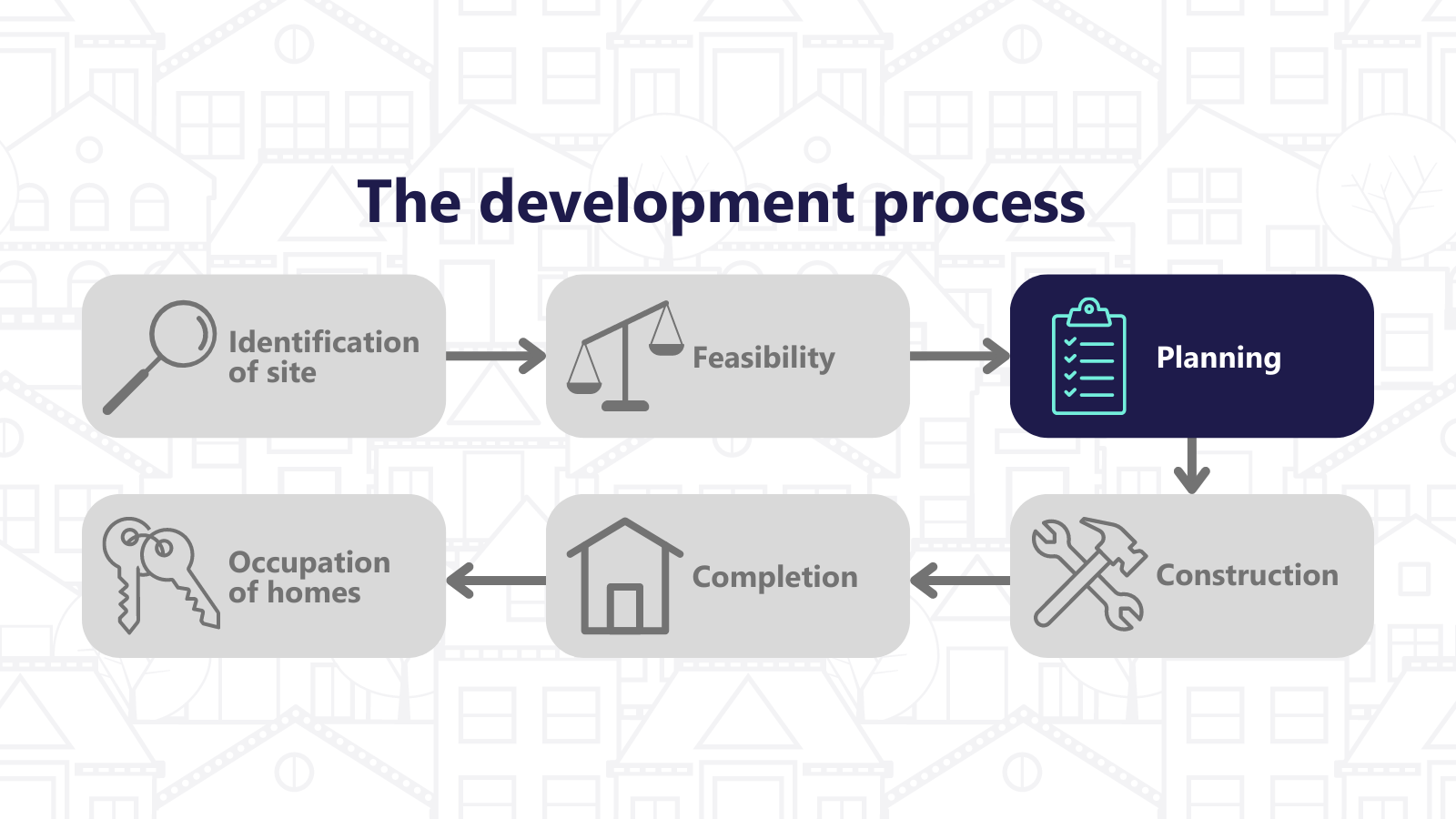Planning


On the basis that a viable scheme has been established, purchase terms agreed and formal legal arrangements in place such as an option agreement or conditional exchange of contracts, it is necessary to secure planning consent for the development proposals. The information necessary for a planning application extends beyond the production of design drawings and plans of the proposals but rather includes many of the surveys and reports commissioned as part of the site assessment and feasibility stages. For example, information will be required on ecological assessments or ground investigations. Similarly, the drawings and plans will also include engineering drawings in respect of highways and drainage layouts.
It is the case that the more comprehensive and complete the information that is submitted with the planning application, then the more smoothly and timely will be the determination of the planning application by the local planning authority. However, whilst more detail is provided below in terms of Sustainable Drainage Systems (SuDS) and SuDS Approval Body (SAB) requirements, it is considered of the utmost importance that the drainage designs and constraints are addressed in tandem with architectural designs, if not partially addressed even before other design work commences. The SuDS and SAB requirements are significant and if not designed in at the earliest possible stage can have an impact on other aspects of design and thereby potentially cause delays and even undermine project viability.
Below is a link to a simple flowchart of the planning application and determination process which essentially comprises three components:
• Pre-application (including formal consultation)
• Planning application
• Determination of application
Pre-application enquiries: Also known as a ‘pre-app’ which is where an applicant can submit its indicative proposals to the local planning authority to establish if the principles of the proposals are broadly acceptable and what are the key issues that need to be addressed by a formal planning application. The response should not be seen as a deemed consent as there will still be a need to submit a planning application and progress through a determination process. In addition, there is fee payable to submit a ‘pre-app’.
Pre-Application Consultation (PAC): This is mandatory for schemes of 10 dwellings or more, though for CLH projects, it might be seen as good practice to undertake such consultation irrespective of the number of dwellings being developed. The PAC process involves a set procedure for maximising publicity of the proposals, consulting with landowners, formal consultation with the community and statutory consultees, addressing responses meaningfully and preparing a PAC Report to accompany the planning application. Information used at PAC stage should be of sufficient detail so as to be as close as possible to the actual application submission and in terms and language that is accessible to all. Welsh Government has issued a best practice guide on such consultation which can be found here: https://gov.wales/sites/default/files/publications/2018-09/pre-application-community-consultation.pdf
Design and Access Statement (DAS): This is a short statement to accompany and support a planning application to explain how the applicant has developed its proposals and design principles, how those proposals are a suitable response to the site and its setting including site specific issues, and how adequate access has been demonstrated for future occupiers and users of the new spaces and dwellings.
Planning Performance Agreement (PPA): This is a project management tool used for the determination of planning applications which is an agreement between the applicant and the local planning authority. It is a guide through the whole planning application process which enables all parties to be clear about what is required of them at all stages of the process, and which defines the timescales for determination of the application. A fee is payable to the local planning authority for a PPA.
Planning gain: This is a mechanism by which local planning authorities can secure additional public benefit from a development proposal. In essence, it seeks to capture some of the uplift in land value generated by the granting of planning permission and if used effectively can ensure that a commercially viable development does not become socially or environmentally unsustainable.
Community Infrastructure Levy (CIL): This is a charge that local authorities can choose to charge on developments in their area to support and fund new social and physical infrastructure such as schools or transport improvements that will be needed to support new development. It is proportionate to the scale of development and exemptions apply when new social or affordable housing is being developed though a scheme-by-scheme approach is adopted, and CIL is not universally applied by local authorities and so this should be checked early as part of the feasibility study.
Section 106 Agreement: These are legal agreements between a local authority and developers linked to planning permissions and can be known as planning obligations. They are drawn up when it is considered that a development will have a significant impact on an area which needs to be moderated through infrastructure improvements. For example, such agreements are often used to secure affordable housing within a wider larger housing development or as a means to protect the affordability in perpetuity.
Unilateral Undertaking (UU): This is a simplified version of a planning agreement offered by the developer where it covenants to perform certain obligations. Whilst a UU is a legal deed, unlike a Section 106 Agreement, it is offered by the developer when planning permission is granted and need not be entered into by the local authority for it to be implemented and effective.
Outline planning: An application and permission, if granted, provides sufficient detail on the scale and nature of the development but which is able to establish that the principle of that form of development is acceptable without having to prepare full technical details of the proposal. Having established the principle of development, it only remains to address the details of the development which is addressed through Reserved Matters. An outline planning permission is valid for three years to address the Reserved Matters.
Reserved Matters approval: This is only applicable if an outline planning permission has been granted. It is the approval of those matters that were not addressed in detail at the outline application stage which for example could include access, landscaping or layout. A Reserved Matters approval is valid for two years from when that last matter was approved or three years from the date of the outline permission, whichever date is the later.
Full or Detailed planning: This is the most detailed application and permission where full details of the development proposal are submitted and approved on all aspects of the proposal. A Full or Detailed planning permission is valid for five years.
Appeal: In the final resort, planning permission can be sought on appeal. This can either be on the basis of non-determination by the local planning authority or if the applicant does not agree with the refusal of its application. The appeal against refusal must be made within six months of the date of the refusal notice with the information provided to the Planning and Environment Decisions Wales department of Welsh Government being the same as that provided in the original application. A decision on the appeal can be expected within 14 weeks of lodging the appeal application. There is recourse to the High Court in the event that an appeal is dismissed.
There are two further points of note concerning the granting of planning permission. Firstly, almost all planning permissions will be granted with conditions. These will include compliance or information only conditions or those that will need discharging with additional information provided to the local planning authority. Such conditions are usually pre-commencement of construction conditions or pre-occupation conditions though there are others that will be related to key milestones in the construction programme. Secondly, there is a Judicial Review period for the granting of planning permission. This is essentially a challenge by a third party of the planning decision on the grounds of illegality, procedural unfairness and irrationality and it must be brought no more than six weeks from the date of the decision notice to grant permission. If the review or challenge is upheld, it has the effect of quashing the original decision to grant planning permission.
The framework for determining planning applications reflects and references the spatial hierarchy of planning policy in Wales from the national to the local level:
National:
• ‘Future Wales – The National Plan 2040’: https://gov.wales/sites/default/files/publications/2021-02/future-wales-the-national-plan-2040.pdf
• Technical Advice Notes (TANs): https://gov.wales/technical-advice-notes
• Planning Policy Wales: https://gov.wales/sites/default/files/publications/2021-02/planning-policy-wales-edition-11_0.pdf
Sub-regional:
• Strategic planning guidance for sub-regions of Wales
Local:
• Local Development Plans (LDPs)
• Supplementary Planning Guidance (SPG)
• Site development briefs
Development management or control:
This is the actual process of determining planning applications which aims to ensure that developments are in accordance with planning policy frameworks and that developments are in the best interests of the general public and the area.
Comprehensive documentation related to planning in Wales can be found through the following Welsh Government website links:
https://gov.wales/building-planning
https://gov.wales/planning-policy-and-guidance-for-professionals
Sustainable Drainage Approval Bodies (SABs) have been established in local authorities and it requires new developments to include Sustainable Drainage Systems (SuDS) that comply with national standards for the design, construction, operation and maintenance of surface water drainage systems serving those new developments.
Applying to new developments of one or more dwellings seeking planning permission since January 2019, the local authority SAB will evaluate and approve surface water drainage systems within development proposals and will require developers to enter into a legal adoption agreement as part of the approval process for the local authority to maintain those systems. A part of the legal agreement will include the payment of commuted sums by the developer to the local authority for the long-term maintenance of those systems. The level of payment will be determined by the nature of the systems proposed.
SAB approval does not apply to refurbishment works to existing properties unless the works involve the creation of more than 100 sqm of new accommodation.
It is noted that a SAB approval is not deemed to be in place as part of the planning approval process. In addition, prior to any construction works commencing, it will be necessary for both the SAB technical approval and legal agreements to be in place.
The rationale behind SuDS and SAB approvals include:
• Reducing the risk of surface water flooding
• Improving water quality
• Addressing issues around climate change in terms of increased flood event and rising sea levels
• Mitigating the trends of urbanisation where greenfield areas become hard surfaces with high water run off rates
• Addressing limitations to capacity within surface water drainage systems
• Creating bio-diverse rich habitats and new community recreational spaces
The types of features within SuDS to be considered by developments seeking SAB approval range from rainwater harvesting to infiltration soakaways to engineering solutions around attenuation tanks prior to connection into the main drainage system. The list below illustrates a hierarchy of solutions:
• Rainwater harvesting
• Green roofs
• Ponds/Water courses
• Filteration strips and swales
• Infiltration soakaways
• Permeable surfaces
• Tanked systems
However, it is important that the feasibility of solutions will be determined by local conditions, particularly geological conditions and features for infiltration solutions. In addition, it is essential that the SuDS features are integrated into the design stage at the very earliest opportunity given that each of the solutions will have significant implications for design, feasibility and viability of CLH housing development schemes. In essence, the designs for SAB and planning approvals need to be integrated and developed simultaneously.
Here is a link to the Welsh Government guidance document: https://gov.wales/sites/default/files/publications/2019-06/statutory-guidance.pdf
Building Regulations are intended to protect people’s health, safety and welfare in and around buildings of whatever use, including residential property. The regulations are designed to improve the conservation of fuel and energy, protect and enhance the environment, and to promote sustainable development.
Being administered by the local authority, a Building Regulations application will be submitted after planning permission is obtained as they require more detailed technical designs to be assessed against the requirements and approved documents in terms of safety and building performance standards. The areas include:
• Structure
• Fire safety
• Energy conservation
• Access
• Sound insulation
• Ventilation
• Drainage
• Heating and electrical
A conditional Building Regulations approval must be obtained before the commencement of construction works with the conditions being discharged through additional information being provided and an inspection and sign off regime for the works being put in place by Building Control Officers. At the satisfactory completion of works and documentation being in place, a completion certificate is issued to allow safe occupation of the new homes, which will very often be required by funders as evidence of completion of works to the required standards.
Here is a link to a Welsh Government publication on Building Regulations: https://gov.wales/sites/default/files/publications/2021-12/quick-guide-to-the-building-regulations.pdf












